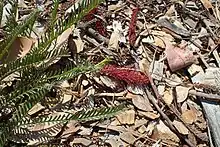Grevillea dryandroides
Grevillea dryandroides, commonly known as phalanx grevillea,[2] is a species of flowering plant in the family Proteaceae and is endemic to the south-west of Western Australia. A diffuse, clumping shrub, it often forms suckers and has divided leaves with up to 35 pairs of leaflets, and groups of red to pinkish flowers on an unusually long, trailing peduncle.
| Grevillea dryandroides | |
|---|---|
 | |
| Grevillea dryandroides in Kings Park Botanic Garden | |
| Scientific classification | |
| Kingdom: | Plantae |
| Clade: | Tracheophytes |
| Clade: | Angiosperms |
| Clade: | Eudicots |
| Order: | Proteales |
| Family: | Proteaceae |
| Genus: | Grevillea |
| Species: | G. dryandroides |
| Binomial name | |
| Grevillea dryandroides | |
Description
Grevillea dryandroides is a diffuse, clumping shrub that typically grows to a height of 10–50 cm (3.9–19.7 in) and often forms suckers. The leaves are divided, usually 70–140 mm (2.8–5.5 in) long with ten to thirty-five pairs of spreading, linear to narrow egg-shaped lobes with the narrower end towards the base, the lobes 6–16 mm (0.24–0.63 in) long and 1.2–2.0 mm (0.047–0.079 in) wide. The flowers are arranged in groups on a trailing peduncle up to 1 m (3 ft 3 in) long, the rachis 30–100 mm (1.2–3.9 in) long and are red to pinkish red, the pistil 17–23 mm (0.67–0.91 in) long. The style has shaggy hairs near its base. The fruit is a follicle 14–16.5 mm (0.55–0.65 in) long.[2][3][4][5][6]
Taxonomy
Grevillea dryandroides was first formally described in 1933 by Charles Gardner in the Journal of the Royal Society of Western Australia from material he collected near Ballidu in 1931.[7][8] The specific epithet (dryandroides) means "Dryandra-like".[9]
In 1993, Peter M. Olde and Neil R. Marriott described two subspecies of G. dryandroides in the journal Nuytsia and the names are accepted by the Australian Plant Census:
- Grevillea dryandroides C.A.Gardner subsp. dryandroides[10] has leaf lobes less than 10 mm (0.39 in) long, the pistil about 17 mm (0.67 in) long, and mainly flowers from August to December;[4]
- Grevillea dryandroides subsp. hirsuta Olde & Marriott[11] has leaf lobes more than 12 mm (0.47 in) long, the pistil 19–23 mm (0.75–0.91 in) long, and mainly flowers from September to December.[4]
Distribution and habitat
Phalanyx grevillea grows in open heath and woodland and is restricted to the Avon Wheatbelt biogeographic region of south-western Western Australia. Subspecies dryandroides grows near Ballidu and subsp. hirsuta between Cadoux and Corrigin.[2][12][13][14][15]
Conservation status
Grevillea dryandroides is listed as "not threatened" by the Western Australian Government Department of Biodiversity, Conservation and Attractions,[2] but both subspecies are listed as "threatened"[12][13] meaning that they are in danger of extinction.[16]
References
- "Grevillea dryandroides". Australian Plant Census. Retrieved 5 April 2022.
- "Grevillea dryandroides". FloraBase. Western Australian Government Department of Biodiversity, Conservation and Attractions.
- "Grevillea dryandroides". Australian Biological Resources Study, Department of Agriculture, Water and the Environment: Canberra. Retrieved 5 April 2022.
- Olde, Peter M.; Marriott, Neil R. (1993). "New species and taxonomic changes in Grevillea (Proteaceae: Grevilleoideae) from south-west Western Australia". Nuytsia. 9 (2): 268–271. Retrieved 5 April 2022.
- "Grevillea dryandroides". Australian Native Plants Society (Australia). Retrieved 4 April 2022.
- "Grevillea dryandroides". Australian National Botanic Gardens. Retrieved 4 April 2022.
- "Grevillea dryandroides". APNI. Retrieved 5 April 2022.
- Gardner, Charles A. (1933). "Contributiones Florae Australiae Occidentalis, VIII". Journal of the Royal Society of Western Australia. 19: 81–82. Retrieved 5 April 2022.
- Sharr, Francis Aubi; George, Alex (2019). Western Australian Plant Names and Their Meanings (3rd ed.). Kardinya, WA: Four Gables Press. p. 187. ISBN 9780958034180.
- "Grevillea dryandroides subsp. dryandroides". Australian Plant Census. Retrieved 4 April 2022.
- "Grevillea dryandroides subsp. hirsuta". Australian Plant Census. Retrieved 4 April 2022.
- "Grevillea dryandroides subsp. dryandroides". FloraBase. Western Australian Government Department of Biodiversity, Conservation and Attractions.
- "Grevillea dryandroides subsp. hirsuta". FloraBase. Western Australian Government Department of Biodiversity, Conservation and Attractions.
- "Grevillea dryandroides subsp. dryandroides". Australian Biological Resources Study, Department of Agriculture, Water and the Environment: Canberra. Retrieved 5 April 2022.
- "Grevillea dryandroides subsp. hirsuta". Australian Biological Resources Study, Department of Agriculture, Water and the Environment: Canberra. Retrieved 5 April 2022.
- "Conservation codes for Western Australian Flora and Fauna" (PDF). Government of Western Australia Department of Parks and Wildlife. Retrieved 5 April 2022.